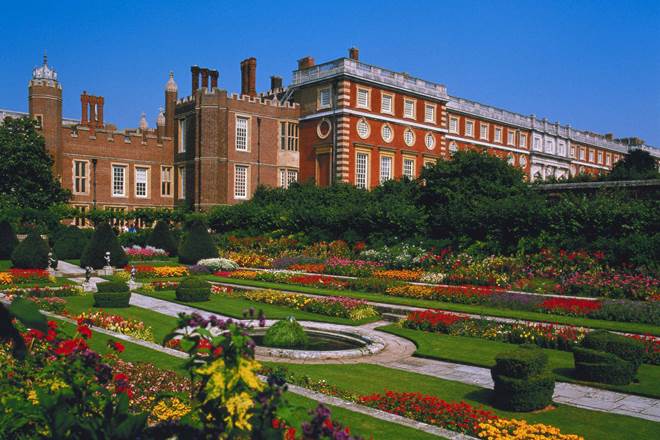Today, we’re on a royally fascinating mission: to delve into the world of the Tudors, where intrigue, beauty, and history collide in the palaces of one of England’s most notorious monarchs: Henry VIII.
From the grandeur of Hampton Court Palace to the royal chambers of St James’s Palace, this guide will transport you back to the Tudor era.
Whether you’re a history buff, an architecture enthusiast, or a fan of the sumptuous settings of The Tudors series, join us on a journey to discover Henry VIII’s palaces in England.
Image Credit: Getty Images, Davis McCardle. Image Location: Hampton Court Palace, London, England
Hampton Court Palace: a Tudor masterpiece
Hampton Court Palace is the jewel of Henry VIII’s crown. With its majestic gardens, famous maze, and historic tennis courts, this palace offers a glimpse into the opulent lifestyle of Henry VIII.
How to get to Hampton Court Palace
Trains run regularly from London Waterloo to Hampton Court station, which is a short walk from the palace gates. This easy access makes it a perfect starting point for your journey through Tudor history.
How long should I plan for my visit to Hampton Court Palace?
Allocate at least half a day to explore Hampton Court Palace thoroughly, though you could easily spend a full day immersed in its history and gardens.
St James’s Palace: the heart of royalty
Located in London, St James’s Palace, with its red-brick facade, has been a pivotal royal residence for centuries.
Henry VIII commissioned its construction between 1531 and 1536 on the site of a former leper hospital dedicated to Saint James the Less. The palace was intended as a smaller residence to complement the larger Whitehall Palace.
Over the centuries it has been a significant royal residence, serving as the official residence of several monarchs. Today, it remains a working palace and the senior, ceremonial royal residence in the United Kingdom even though the sovereign no longer resides there.
Can I visit St James’s Palace in London?
Though not open to the public like Hampton Court, St James’s Palace’s historical significance and architectural beauty make it a must-see from the outside.
Image Credit: Getty Images, tupungato. Image Location: Dublin Castle, Dublin, Ireland
The Tudors filming locations
Plot twist: The Tudors TV drama barely shot any of its scenes at Hampton Court Palace’s grand rooms and expansive gardens. Instead, they used some camera tricks and filmed most of the show in Ireland.
So, where did the magic happen? Hold onto your ruffs and doublets; here’s the real scoop of The Tudors filming locations in Ireland:
- Drimnagh Castle, Dublin. Think brave knights (although it’s probably just a tour group now) and mystical intrigue among medieval walls.
- Dublin Castle. A major attraction in the heart of Dublin.
- Kilmainham Gaol (former prison, now a museum in Dublin). Spooky, historical, and perfect for plotting a Tudor escape plan.
- Powerscourt Estate, Wicklow. Gardens so pretty, you won’t be able to help but stop and admire.
- Christ Church Cathedral, Dublin. A stunning cathedral you won’t want to miss.
- Ardmore Studios, Bray, Wicklow. Where TV magic happens.
- People’s Gardens, Phoenix Park, Dublin. Where courtiers would maybe gossip and plot.
- Kilruddery House, Wicklow (Season 4). So posh, it’s practically Tudor royalty in disguise.
Image Credit: Getty Images, sasar. Image Location: Powerscourt Estate, Wicklow, Ireland
Travel tips for Tudor enthusiasts
- Plan your visit: To fully enjoy the experience, consider joining a guided tour of Hampton Court Palace to uncover stories hidden within its walls.
- Don’t miss out on events: Keep an eye out for historical reenactments and events at Hampton Court that offer a deeper dive into Tudor daily life.
- Download the Trainline app: you’ll need it for smooth train travel around England and beyond.
How many palaces did Henry VIII have, and which ones can you visit?
Henry VIII wasn’t just a king with a knack for swapping wives; he was also a real estate mogul of the Tudor era. Just think about it: he had a whopping 55 palaces scattered around his kingdom!
Here’s a tour through some of these majestic homes:
- Hampton Court, London. Perhaps Henry’s most renowned palace. Open to the public, it’s a visitor’s dream with its grandeur, gardens, and ghosts.
- Sudeley Castle, Gloucestershire. Where Catherine Parr lived and died. Open for public tours, offering a peek into royal life and lush gardens.
- Nottingham Castle. Now a museum and art gallery welcoming visitors.
- Woodstock Palace, Oxfordshire. The remains of this demolished palace are now within the grounds of Blenheim Palace, accessible with admission for a historical and architectural feast.
- Nonsuch Palace, Surrey. The palace itself is gone, but the park remains open to the public.
- Oatlands Palace, Surrey. The original palace is gone, but Oatlands Park now hosts a hotel.
- New Hall or the Palace of Beaulieu, Essex. Lady Mary’s residence, under the care of the Marquis of Northampton. It’s a private school now but opens for special events.
- Carew Manor, Beddington. Overseen by Sir Michael Stanhope, some areas are accessible as a public park, offering a green escape.
- Richmond Palace, Surrey. Yet another spot where William Griffithe managed the royal wardrobe. The palace ruins are private, though Richmond is yours to explore.
Image Credit: Getty Images, JaimePharr. Image Location: Nottingham Castle, Nottingham, England
Are there any combined tickets for visiting multiple Tudor palaces?
While individual tickets are required for each palace, look for passes like the London Pass, which offers access to multiple attractions, including Hampton Court Palace.
Each of Henry VIII’s palaces tells a story, from the political intrigues of Hampton Court Palace to the royal ceremonies of St James’s Palace. As you walk through these historic sites, you’re treading the same paths as kings, queens, and courtiers from over 500 years ago.
So, dust off your doublet, don your ruff, and step into the world of the Tudors to experience the legacy of Henry VIII’s England firsthand! And remember, English treasures are not limited to royal palaces. Download the Trainline app today to get exploring other beautiful places in England by train.
Header Image Credit: Getty Images, Doug Armand. Image Location: Hampton Court Palace, London, England



